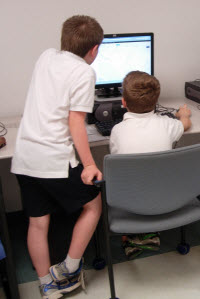Peer to peer teaching is an effective teaching method that can be used in the computer lab to enhance learning. This blog article examines an example of how this method was implemented, elements of successful peer teaching, and the educational value of this approach.
What is Peer to Peer Teaching?
Peer to peer teaching has students take on a teaching role in a school setting in order to share their knowledge with other students.

An Example of Peer to Peer Teaching used in the Computer Lab
I have been teaching the technology project TechnoJourney to a class of Grade 3/ 4 students. Each week students completed a range of Internet-based activities. To celebrate our learning, at the end of the project, another Grade 3 class in the school was invited to participate in an Internet Tour Guide Event.
UPDATE: TechnoJourney was replaced with TechnoInternet. The activities are similar.
In the Internet Tour Guide Event, students became Peer Teachers. The Peer Teachers were divided into groups and then assigned a topic to teach. There were six topics: Super Searcher, Trust Test, E-Library, Picture Power, Learn with Videos, and Making Map. To prepare for the activity, prior to the event, each Peer Teacher group practiced teaching to each other using instruction sheets as a guide. This allowed them an opportunity to gain confidence in their ability to teach. To learn more, refer to the blog post, “Internet Tour Guide Activity“.
The following week, the Grade 3 class visited the computer lab as “Tourists” or students that would learn about the Internet from the “Internet Tour Guides” or Peer Teachers. To get more than 40 students into the computer lab at one time required organization. To start, the Grade 3 / 4 students arrived in the computer lab, assembled into their Peer Teaching groups, grabbed their worksheets, and then stood behind a computer chair.

In the meantime, the other Grade 3 class was patiently waiting outside the computer lab. Once the peer teachers were ready, three to four students were let into the computer lab at one time, and directed to sit in front of a particular computer. Once everyone was seated, the activity was introduced.
Students were told that they were going to become Tourists and would be taking a journey through the Internet. Their Internet Tour Guides (Peer Teachers) were going to guide them to online destinations. Tourists were informed that they needed to follow their Tour Guides’ directions.
With over 40 students in the room and active teaching happening in every group, it was a busy but exciting place! The room soon became a hive of active learning as the Tour Guides were eager to share their newfound skills. The Tourists enjoyed the novelty of the learning experience from their peers as well as getting to visit new places on the Internet.
After about 8 minutes the lights were turned off to signal it was time to move to the next destination. Once the room was quiet, the Tourists were rotated clockwise to the next group of Tour Guides. For example, the Tourists at the Super Searcher destination, moved to the Trust Test destination, the Tourists as the Trust Test destination moved to the E-Library destination, and so on.
Although we ran out of time and only managed to rotate the Tourists through three of the six activities, it was a complete success.
Elements to Successful Peer to Peer Teaching
Below are the elements that helped to ensure the success of the Internet Tour Guide Event:
- Peer teachers had instruction sheets to use as a guide
- Peer teachers were able to practice before the event
- Challenges were available to keep students focused or if there was extra time
- Teachers never touched the mouse – used only words to explain or fingers to point at the screen
- The lesson should be adjusted to the learner – areas of interest were used for searches
- Decisions were made prior to the event about how to organize peer teachers and students within the computer lab
- A signal was selected in advance to rotate the students from one group of peer teachers to another
- Each rotation was brief to make sure that peer teachers and students stayed focused on the task
Peer to Peer Teaching Benefits
There are many benefits to peer teaching:
- Consolidate Learning: By teaching to a peer, students review their own learning, which allows them to strengthen their own knowledge and skills.
- Increase Confidence: This type of learning activity boosts self-confidence because students realize that the classroom teacher perceives them as experts and trusts them enough to share their expertise with a peer.
- Develop Communication Skills: Students must use strong communication skills to be able to provide clear directions, listen to feedback, and then adjust the next set of instructions accordingly so that their peer is successful.
- Assess Learning: The teacher is able to assess students’ understanding of the material based on their ability to share their knowledge and skills with a fellow peer, that could not be accomplished using a paper and pencil test.
Other Articles about Teaching Internet Skills using TechnoJourney
Now the Students’ Turn: Reflecting on TechnoJourney
A Teacher Speaks Out: Yes, you should teach Internet skills!
Peer to Peer Teaching – Students Become the Teachers
Use YouTube Videos in your Classroom
Students Love Google Maps
Review How to Sort Google Images with Your Students
Teaching Internet Skills – The Trust Test
Wikipedia in the Classroom
Bookmarking is a Basic Internet Skill that can be Complex
Metacognition and Teaching about the Internet
4 Strategies for Reviewing Internet Search Results
When Should Students Start Using the Internet?
Should you Teach Internet Skills?
